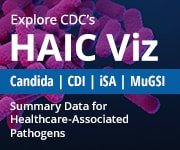Candida Bloodstream Infections
Overview
Candida, a yeast that normally lives in and on the human body, is one of the most common causes of bloodstream infections in the United States; however, information about this infection in large populations is limited.
Learn more about symptoms, risk factors, diagnosis, prevention, and numbers of Candida infections.
CDC performs active population-based surveillance for candidemia (Candida bloodstream infections) through the Emerging Infections Program (EIP) Healthcare-Associated Infections Community (HAIC) Interface. The EIP candidemia surveillance activity was launched in 2008 and has expanded to select counties in 10 EIP sites across the United States.
Surveillance Objectives
Through the EIP HAI candidemia surveillance project, CDC monitors epidemiologic trends in candidemia and performs species confirmation and antifungal susceptibility testing on all available Candida bloodstream isolates to:
- Track incidence of candidemia and monitor laboratory and epidemiologic trends,
- Identify new risk factors for candidemia,
- Detect changes in resistance to antifungal agents and communicate these results back to submitting laboratories,
- Determine the burden of infections due to antifungal-resistant Candida species and understand the causes of resistance,
- Identify areas where candidemia prevention and intervention strategies can be focused.
Methods
Surveillance Population
The table below lists the EIP areas conducting surveillance for candidemia:
| Emerging Infections Program Site | Year Candidemia Surveillance Started | Area Under Surveillance |
|---|---|---|
| California | 2017 | Alameda County |
| Colorado | 2017 | 5 counties in metropolitan Denver |
| Connecticut | 2019 | Statewide |
| Georgia | 2008 | 8 counties in metropolitan Atlanta |
| Maryland | 2008 | Baltimore City and County |
| Minnesota | 2017 | 7 counties in Minneapolis-St. Paul metropolitan area |
| New Mexico | 2017 | Bernalillo County |
| New York | 2016 | Monroe County |
| Oregon | 2011 | 3 counties in metropolitan Portland |
| Tennessee | 2011 | 17 counties that incorporate Knoxville and surrounding areas |
Case Definition
A case of candidemia is defined as a positive blood culture for any Candida species in a patient who lives in the catchment area, and whose culture is collected within 12 hours of death if the patient is deceased. A patient with a positive Candida blood culture collected greater than 30 days after the initial positive culture is considered to have a new case of candidemia.
Case Ascertainment
Candidemia cases are identified based on positive blood cultures for Candida species from all inpatient and outpatient clinical laboratories serving the population within the surveillance catchment areas. Each laboratory regularly provides reports of positive Candida blood culture results to the local EIP site.
Data Collection
Data collection is performed by trained surveillance epidemiologists at each EIP site. For each candidemia case, a review of medical records is performed to gather demographic characteristics, location of culture collection, underlying health conditions, healthcare exposures, and other risk factor information.
Laboratory Characterization
Incident Candida isolates collected from cases are sent to CDC to confirm species identification and perform antifungal drug susceptibility testing. Laboratory results from testing at CDC are communicated back to submitting facilities and laboratories.
Analysis
Data analysis is performed to describe changes in candidemia incidence over time and changes in molecular epidemiology, and to evaluate disease burden and health disparities to guide public health interventions.
Recent Trends
Surveillance data show that approximately 9 out of 100,000 persons developed culture-positive candidemia annually in 4 U.S. EIP sites during 2012–2016.
Groups of people more highly affected by candidemia include:
- Adults aged 65 and older
- Babies less than 1 month old
- Black or African American people
- People who inject drugs
- People who have had recent surgery, exposure to broad-spectrum antibiotics, or a central venous catheter
During 2012–2016, 1 in 4 patients with candidemia died while hospitalized, suggesting this infection is associated with substantial risk of death. About 10% of cases occurred in patients with a history of injection drug use, mostly in younger adults. In recent years, injection drug use has become an important risk factor for candidemia.
Learn more about recent trends.
Related Links
- CDC: Invasive Candidiasis Statistics
- Toda M, Williams SR, Berkow EL, Farley MM, Harrison LH, Bonner L, Marceaux KM, et al. Population-Based Active Surveillance for Culture-Confirmed Candidemia — Four Sites, United States, 2012–2016, United States, 2012–2016. MMWR. 2019 Sept 27
- Barter DM, Johnston HL, Williams SR, Tsay SV, Vallabhaneni S, Bamberg WM. Candida Bloodstream Infections Among Persons Who Inject Drugs — Denver Metropolitan Area, Colorado, 2017–2018. MMWR. 2019 March 29
- Zhang AY, Shrum S, Williams S, Petnic S, Nadle J, Johnston H, et al. The Changing Epidemiology of Candidemia in the United States: Injection Drug Use as an Increasingly Common Risk Factor – Active Surveillance in Selected Sites, United States, 2014–2017. Clin Infect Dis. 2019 Nov 2
- Seagle EE, Jackson BR, Lockhart SR, Georgacopoulos O, Nunnally NS, Roland J, et al. The Landscape of Candidemia During the Coronavirus Disease 2019 (COVID-19) Pandemic. Clin Infect Dis. 2021 June 18
- Gold JAW, Seagle EE, Nadle J, Barter DM, Czaja CA, Johnston H, et al. Treatment Practices for Adults with Candidemia at Nine Active Surveillance Sites – United States, 2017-2018. Clin Infect Dis. 2021 June 3
